While the Orion constellation is named after the hunter in Greek mythology, it is anything but stealthy. Orion, which is located on the celestial equator, is one of the most prominent and recognizable constellations in the sky and can be seen throughout the world.
Orion is the brightest and most beautiful of the winter constellations. Some of its stars, including Betelgeuse and Rigel, are among the brightest stars.
Credit: Starry Night Software
Locating Orion the Hunter
Orion is clearly visible in the night sky from November to February. Orion is in the southwestern sky if you are in the Northern Hemisphere or the northwestern sky if you are in the Southern Hemisphere. It is best seen between latitudes 85 and minus 75 degrees. Its right ascension is 5 hours, and its declination is 5 degrees.
Alnilam, Mintaka and Alnitak, which form Orion’s belt , are the most prominent stars in the Orion constellation. Betelgeuse , the second brightest star in Orion, establishes the right shoulder of the hunter. Bellatrix serves as Orion’s left shoulder.
The Orion Nebula — a formation of dust, hydrogen, helium and other ionized gases rather than a star — is the middle “star” in Orion’s sword, which hangs off of Orion’s Belt. The Horsehead Nebula is also nearby.
Other stars in the constellation include Hatsya, which establishes the tip of Orion’s sword that hangs off the belt, and Meissa, which forms Orion’s head. Saiph serves as Orion’s right knee. Rigel , Orion’s brightest star, forms the hunter’s left knee.
With one exception, all of the main stars in Orion are bright young blue giants or supergiants, ranging in distance from Bellatrix (243 light-years) to Alnilam (1,359 light-years). The Orion Nebula is farther away than any of the naked eye stars at a distance of about 1,600 light-years. One light-year is the distance light travels in a single year, about 6 trillion miles (10 trillion kilometers).
The exception is the star Betelgeuse, which is a red giant and one of the largest stars known. It is also the only star in the sky large enough and close enough to have been imaged as a disk in the Hubble Space Telescope. Observers with a keen eye should be able to see the difference in color between Betelgeuse and all the other stars in Orion. [Space Photos: Orion Nebula & Other Stunning Views ]
Exoplanet possibilities
The constellation of the hunter has also proven a fertile hunting ground for extra-solar planets, or exoplanets , planets beyond the solar system. Here are a few of the planets (or potential planets) that have been discovered in stars that fall within Orion’s boundaries in the Earth’s sky:
The star CVSO 30 is 1,200 light-years away and likely hosts a couple of potential planets. In 2012, the Very Large Telescope in Chile managed to image possible exoplanet CVSO 30c directly, an incredible feat given that CVSO 30 is roughly 280 times farther than Earth is to the nearest star system (Alpha Centauri). CVSO 30c (if it exists) is a gas giant that orbits its star at a distance of 660 astronomical units (Earth-sun distances) and makes an orbit every 27,000 years. The other candidate planet is gas giant CVSO 30b, which by contrast is extremely close — just 0.008 AU from its star.
A Jupiter-size potential exoplanet, PTFO8-8695b , is about 1,100 light-years from Earth and (if it exists) is so close to its star that its outer layers are being ripped away from the rest of the planet. The star’s system showed high-energy hydrogen emissions that can’t be explained by stellar activities or features, according to astronomers.
There are a few other probable planets in Orion as well, although their existence may be proved or disproved with more observations. These include HD 38529 b and HD 38529 c (two gas giants orbiting in a system with a huge debris disk), HD 38858 b (a gas giant orbiting in the habitable zone of its star) and HD 37605 b (a gas giant that orbits extremely close to its parent star.)
The stars Alnilam, Mintaka and Alnitak form Orion’s belt.
Credit: Martin Mutti, Astronomical Image Data Archive
Mythology
There are several versions of the myth of Orion, but one of the more common iterations is that Orion proclaimed himself to be the greatest hunter in the world, much to the dismay of Hera, the wife of Zeus. She had a scorpion kill him, and Zeus put Orion into the sky as consolation. In another version, Orion is blinded for raping Merope, a granddaughter of the god Dionysus. He has to travel East to seek the sun’s rays to recover his sight.
While the name Orion is steeped in Greek mythology, many cultures have been influenced by the story of this constellation. Orion has also associated with an Egyptian pharaoh of the Fifth Dynasty nameed Unas. In Hungary, Orion is known as (magic) Archer (Íjász), or Scyther (Kaszás). Scandinavians refer to Orion’s Belt as Frigg’s Distaff.

0 of 10 questions complete
Additional reporting by Elizabeth Howell, Space.com contributor.

Comments are closed.